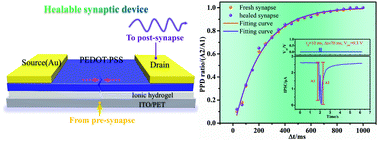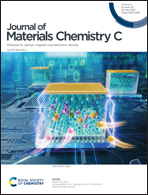An intrinsically healing artificial neuromorphic device†
Abstract
Neuromorphic devices represent the essential components for the future artificially intelligent and biomimetic electronics. However, the reported neuromorphic devices only mimic the electronic behaviors of biological synapses while lacking the corresponding physical biomimetic properties, particularly healable capability similar to that of living tissues, which poses a key compatibility limitation for their practical applications. Here, for the first time, we have constructed an intrinsically healing synaptic device, wherein both the channel layer and the electrolyte heal at ambient conditions by utilizing an intrinsically healed semiconducting material and dielectric material. Such devices are capable of efficiently restoring their mechanical and electrical performances after encountering substantial catastrophic damage. More importantly, the essential functionalities of synapses such as paired-pulse depression, spike-timing-dependent plasticity, and spike-voltage-dependent depression as well as depression adaptation behaviors are also well-retained in this artificial synaptic device after completely cutting followed by healing. In this study, for the first time, we have reported the healing neuromorphic synaptic device, shedding light on the future development of more bioinspired humanoid robots, bioimplantable neural prosthetics, exoskeletons, and cybernetic devices integrated with biological and artificial organs.



 Please wait while we load your content...
Please wait while we load your content...